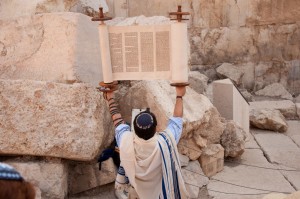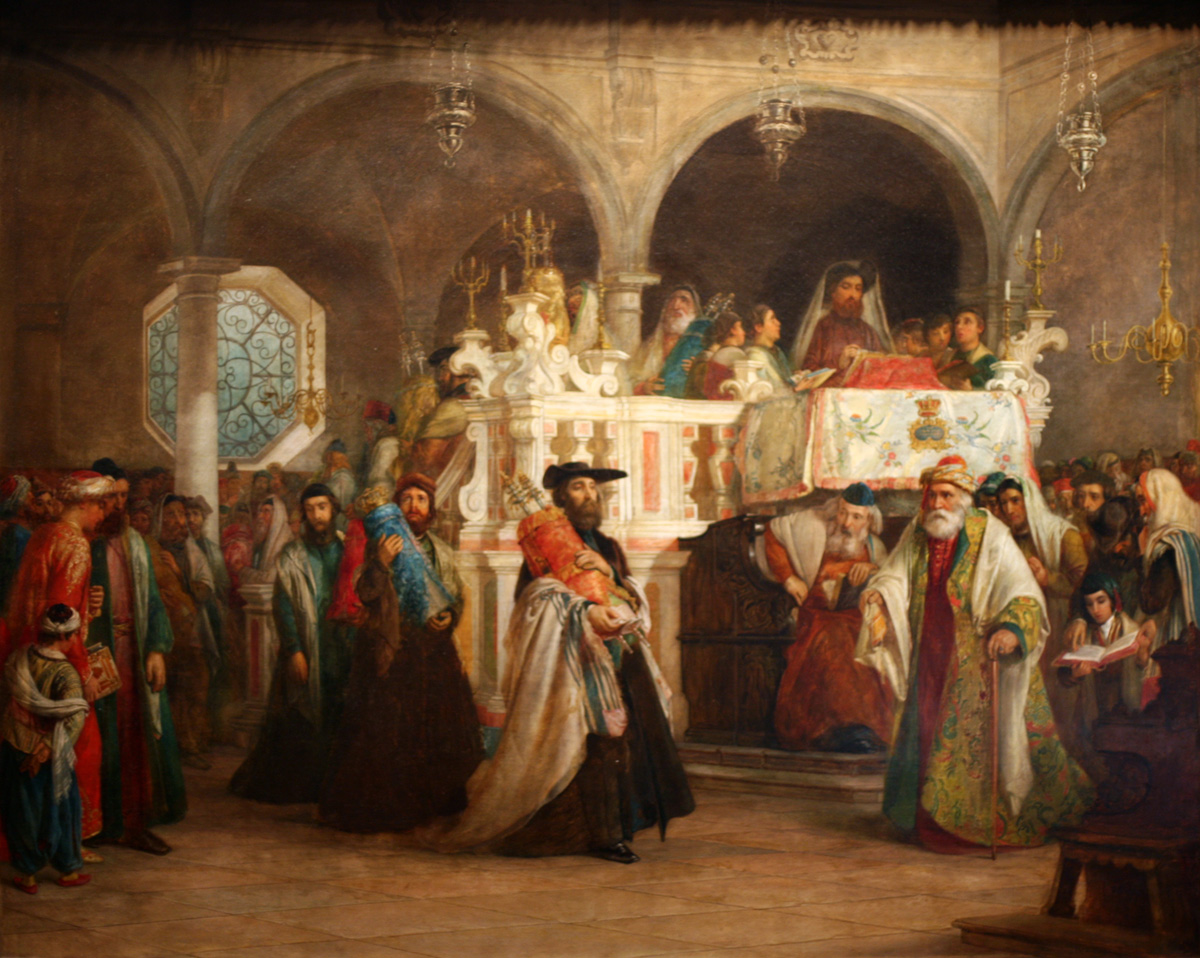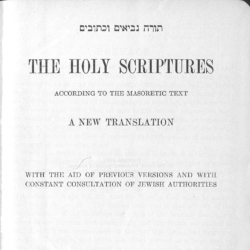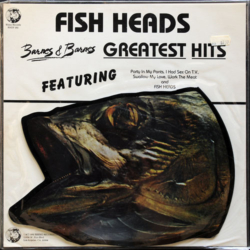Two features make this edition of the Tanakh unique: Full editorial documentation and a free content license.
- Full editorial documentation: Various editions of the Torah or Tanakh in Hebrew may seem identical to the untrained eye, but the truth is that each and every edition—from Koren to Breuer and from Artscroll to JPS—makes numerous important editorial decisions. In most editions these decisions are not transparent, and the student of Torah therefore relies upon the good judgment of the editor. But in Miqra `al pi ha-Mesorah the entire editorial process and the reasoning behind it are fully described in all of their details: Every stylistic alteration and every textual decision made regarding every letter, niqqud, and ta`am in the entire Tanakh is documented. An extensive, six-chapter methodological introduction describing the editorial process in great detail is available here (in Hebrew).[2] The basic method for establishing textual details in this edition is similar to that of Mordechai Breuer and Miqra’ot Gedolot Haketer, both of which are extremely similar to each other: Despite the impression one can get from reading the literature about them, the differences between them are nearly insignificant compared to their similarities. Both of them largely conform to the original conclusions of Israel Yeivin regarding the reconstruction of the Aleppo Codex in its missing parts for niqqud and te`amim, and to the conclusions of Breuer himself for the letters. This new edition differs from both Breuer and MGH significantly more than they differ from each other. All of the editing has been done from scratch according to methodological details that are explained in the extensive introduction. The most visibly unique feature of this edition is in its formatting, which will be described briefly below.
- Free Content License: Unlike most other modern editions of the Tanakh, Miqra `al pi ha-Mesorah is made available under a free and open license for public use (CC-BY-SA). This license covers both the text itself and its extensive documentation.
There are currently two other important digital versions of the Tanakh online, but neither of them benefits from both of the above features:
- The first is Mechon Mamre, which is a very good, accurate online version of the Tanakh according to the mesorah (approximating the Breuer methodology). But it lacks documentation, and it is not available under a free license: You can make limited private use of it without asking for permission and paying a fee, but you cannot reproduce it or improve it (e.g. by posting it on your website together with a translation, commentary, or any other added feature).
- The second is the Westminster Leningrad Codex (WLC), a professional academic edition whose creators have graciously made it available with no restrictions. But its text is not entirely appropriate for Jewish use. The WLC is an attempt to create an exact digital representation of one extremely important manuscript, called the Leningrad Codex, but includes all of its thousands of idiosyncrasies and blatant errors. The practical purpose of the WLC is to provide a justifiable base text for bible translators, linguistic analysis, and other technical academic goals, and for that the Leningrad Codex is sufficient. But it is insufficient for Jews who want to study, read or chant the Torah and the Tanakh according to their niqqud and te`amim.[3] An added indication of its practical purpose is the fact that the WLC omits basic elements of the Leningrad Codex when they are irrelevant to Christian translators and scholars, such as the division of the Torah into weekly readings, and of the Tanakh into sedarim. The parashah divisions (open and closed) are not represented visually, and the “song” formatting is not represented at all. These are all basic elements of the Leningrad Codex, and of the traditional Jewish division of the Tanakh for public reading, but they are not reproduced in the WLC. The chapter divisions are added instead.
The most visibly unique element of this new edition is that it has been formatted as a Tiqqun Qorim, by providing helpful features to the reader that are not always present in the manuscripts and older editions. For instance, when the final syllable of a word is not stressed, an extra ta`am has been added consistently in the proper place (pashta, zarqa, segol, telisha). Legarmeih and paseq are distinguished.[4] Implementation is still in progress on this feature. Qamaz qatan has been added in full (alternatives are documented where traditions differ about its application). These and many other stylistic features are described in chapter two of the introduction (in Hebrew).
The parashah divisions (parashah petuhah and parashah setumah) are indicated visually (not with the letters פ and ס), in way that maximizes their impact on a computer screen or in print, and is consistent with their use in the Aleppo Codex and by the Rambam. Sifrei Emet (the three poetic books Psalms, Proverbs, and Job) appear in an entirely new format (see the full text of Proverbs here for example).[5] The new format for Sifrei Emet and the reasoning behind it are discussed in detail here.
Many more features can be added to the text in the future. Some volunteer programmers are already working on it offsite. Other volunteers who want to suggest corrections, add new features, or help improve this edition in any other way are welcome to make contact. Those who want to create derivative versions of it with special capabilities are also entirely welcome. The only condition is that they make their own work freely available to others under the same open terms as the work they used.
Some features of this edition are still under construction and not fully implemented (the most obvious being the markings for chapter and verse numbers). Here too, anyone who wants to help is welcome.
Readers and contributers are invited to copy small or large portions of this online Tanakh, and to otherwise use it (and even help to improve it!) in any positive way that furthers the study of Torah. The project is hosted at Hebrew Wikisource (this experimental version is meant to eventually become the main Tanakh text at Wikisource). To begin using Miqra `al pi ha-Mesorah, please go to its main index (or here for the weekly Torah readings and here for the Prophets and Writings).
Notes
| 1 | The first complete draft was finished on erev Shabbat Parashat Ki Teze, 10 Elul 5773; August 16, 2013. |
|---|---|
| 2 | The basic method for establishing textual details in this edition is similar to that of Mordechai Breuer and Miqra’ot Gedolot Haketer, both of which are extremely similar to each other: Despite the impression one can get from reading the literature about them, the differences between them are nearly insignificant compared to their similarities. Both of them largely conform to the original conclusions of Israel Yeivin regarding the reconstruction of the Aleppo Codex in its missing parts for niqqud and te`amim, and to the conclusions of Breuer himself for the letters. This new edition differs from both Breuer and MGH significantly more than they differ from each other. All of the editing has been done from scratch according to methodological details that are explained in the extensive introduction. The most visibly unique feature of this edition is in its formatting, which will be described briefly below. |
| 3 | An added indication of its practical purpose is the fact that the WLC omits basic elements of the Leningrad Codex when they are irrelevant to Christian translators and scholars, such as the division of the Torah into weekly readings, and of the Tanakh into sedarim. The parashah divisions (open and closed) are not represented visually, and the “song” formatting is not represented at all. These are all basic elements of the Leningrad Codex, and of the traditional Jewish division of the Tanakh for public reading, but they are not reproduced in the WLC. The chapter divisions are added instead. |
| 4 | Implementation is still in progress on this feature. |
| 5 | The new format for Sifrei Emet and the reasoning behind it are discussed in detail here. |

“מקרא על פי המסורה | Miqra `al pi ha-Mesorah: A New Experimental Edition of the Tanakh Online” is shared through the Open Siddur Project with a Creative Commons Attribution-ShareAlike 4.0 International copyleft license.








Just a question, as I am not an expert in copyright law: if I am transcribing a prayer from an old siddur and there are scriptural pieces in there, am I allowed to copy text from Mechon Mamre without specifying that I copied from them?
I’m asking this because I think there are many “qulot”
* It’s the Bible, Mechon Mamre cannot copyright a text that is more than 2500 years old.
* If the text in the siddur is different I may use the version of the siddur – I use Mechon Mamre just to avoid typing large portions of text with niqqud, a really boring work, but what I want to reproduce is the prayer in the siddur
I’d like to know if someone knows something about this situation, and if it would be different with Wikisource (as it isn’t in the public domain either)
Moadim le-Simchah.
1. You can use parts of Mechon Mamre under fair use terms (like for small pieces of a siddur), but not more than that.
2. They cannot copyright a text that is thousands of years old. But they can copyright a text that they have edited according to their own personal criterion, and that is exactly what they have done. It is also what we have done at Wikisource, but unlike MM we have released it under an open license. To understand what “editorial criterion” mean in an edition of the Tanakh, read the introduction.
For future reference: This announcement now appears as an English-language abstract describing this Tanakh project, at this link:
https://en.wikisource.org/wiki/User:Dovi/Miqra_according_to_the_Mesorah
The version at that link will be corrected and updated appropriately as the project progresses.
Thanks for all your work Seth. OpenScriptures now have an XML version which can be used by software developers (https://github.com/openscriptures/morphhb/tree/master/MAPM) so hopefully your work will be widely used.
Could I make a plea for an English translation of your Introduction, for those goyim like myself who find Evrit difficult?
Hi David,
I’ve long been under the impression that the area of biblical studies in which the biggest gap exists between Israeli scholarship and elsewhere, is precisely in the area of Masoretic scholarship. The gap is because of the language gap. In my personal opinion, the Israeli work in this area is both different and far beyond what goes on elsewhere, and most of it has never been translated.
Regarding a translation, the full introduction isn’t complete yet even in Hebrew, so I couldn’t translate it yet even if I wanted to. Only chapters 1-2 are fully done, and I hope to finish 3-4 in the coming months. Even then I can honestly say that I won’t have the time or ability to translate it (it’s huge), but there is still light at the end of the tunnel: This is the true beauty of Open Content, namely that anyone can just go ahead and translate it themselves!
I would be gratified if you or anyone else would publicize a call for volunteers to translate it as Open Content.
Do note that the English and Hebrew Abstracts are basically identical.
David, in the meantime the continually updated English Abstract is here:
https://en.wikisource.org/wiki/User:Dovi/Miqra_according_to_the_Mesorah
I added an English translation of the chapter titles in the Hebrew Introduction. Hope that helps at least a bit.
Thanks for helping those of us behind the language barrier as much as possible. I appreciate that it is irksome to translate a subject which is natively Hebrew into English and those of us who are serious about this should increase our grasp of Evrit.
>> “Legarmeih and paseq are distinguished.” (Implementation is still in progress on this feature.)
Seems like this could be programmed almost trivially, since the number of legarme not followed by revia or munah revia (e.g, Lev. 21:10) is very, very small, while conversely, the number of revia preceded by munah+paseq (easily mistaken for legarme) is exactly one (Isa. 42:5). But if I am wrong about this, someone please set me straight. I will be only grateful.
Hi Todd, what you write is generally true for the 21 books (though there are different rules for the 3 poetic books). The places where identification of legarmeih verses pasek is questionable are rare, but they do exist here and there (so complete automation is not possible, but it could still do the vast majority of the work).
However, the implementation of the feature has since been completed (even for the 3 poetic books), so the point is now moot. Every legarmeih and pasek in the Tanakh has already been tagged, and the rare places that are uncertain already have special notes.
If you want to make use of this project, please be aware the its technical basis has been transferred to a spreadsheet, its various elements have been organized there, and numerous corrections have been made. The spreadsheet is here:
https://docs.google.com/spreadsheets/d/1mkQyj6by1AtBUabpbaxaZq9Z2X3pX8ZpwG91ZCSOEYs/edit#gid=920165745
Would it be possible to double the necessary ta’amim (dechi, tzinnor) in the three poetic books as well? I have never seen it done, and I have long found that frustrating.
You write: an extra ta`am has been added consistently in the proper place. I know the interpretation of the accents is disputed. I have worked with the musical deciphering key of Suzanne Haïk-Vantoura these last dozen years, and there is no interpretation that comes close to making these te’amim transparently clear and beautiful to a musician. (I have lots of examples) One problem with later editions like Letteris, is that extra methegs have been inserted, and there is no distinction in shape or Unicode value between metheg and silluq. The silluq brings the variable reciting note back to the tonic. A metheg is a pronunciation issue and is largely unimportant to a singer and it is not designed as part of the music. So these extra methegs change the music inadvertently, sometimes for the worse. When you say that you have added an extra ta’am – what are you doing exactly? If you could you give an example, I will tell you how it affects the music.
Hi Bob,
“An extra ta`am has been added consistently in the proper place” refers to four specific te`amim that are always written at the very beginning of a word or at its end, regardless of which syllable is accented. In the Tiberian manuscripts, these te`amim are sometimes indicated an extra time within the word at the beginning of the accented syllable. But that is only partial (for pashta) and rare for the other three (in places where there might otherwise be some question as to where the accent belongs). In MAPM it is full, for the benefit of the reader.
This extra notation is completely independent of the musical rendition (i.e. it should be the same syllable regardless of rendition), whether that rendition is an attempt to “reconstruct” the Tiberian music or the renditions of various Jewish communities around the would.
The extra notation also has nothing to do with meteg. Most Bible editions published in modern times have the numerous “extra” metagim that you describe, which are based on Ashkenazic manuscripts from the middle ages. MAPM does not have them, because it is based on the Tiberian masorah.
Thanks for the clarification. Such adjustments would have no effect on the musical interpretation using Haïk-Vantoura’s deciphering key. Thank you also for the additional information on methegs. I was not aware of their origins. The deciphering key can accept them easily, but they do change the music if they are accepted.
For your information I have digitized the Letteris 1882 edition to add to the other digital versions online for anyone who is interested at https://github.com/benemanuel/letteris
There is a typographical error in Exod 20:9 first word, it has an extra Ta`am. The word is וְי֨וֹם֙
Fred, there is double cantillation in the ten commandments. The קדמא is for טעם תחתון and the פשטא is for טעם עליון.
For a comparison see here:
https://he.wikisource.org/wiki/%D7%A2%D7%A9%D7%A8%D7%AA_%D7%94%D7%93%D7%91%D7%A8%D7%95%D7%AA/%D7%98%D7%A2%D7%9E%D7%99%D7%9D#%D7%94%D7%98%D7%A2%D7%9D_%D7%94%D7%AA%D7%97%D7%AA%D7%95%D7%9F_%D7%9E%D7%95%D7%9C_%D7%94%D7%98%D7%A2%D7%9D_%D7%94%D7%A2%D7%9C%D7%99%D7%95%D7%9F_(%D7%9C%D7%A4%D7%99_%D7%94%D7%9E%D7%A1%D7%95%D7%A8%D7%94_%D7%94%D7%98%D7%91%D7%A8%D7%A0%D7%99%D7%AA)
Seth Shalom,
Your answer and the wikisource page seems to show a complete disregard of the Mesora’s usage of multiple cantillation. The page doesn’t even include once the full cantillation without the artificially created upper/lower division. The “double” cantillation exist for a purpose and can not “just” be eradicated or split. They exist not only in the Ten Commandments but in some twelve other places in the entire Tanach (according the the Letteris edition).
Avraham,
The double cantillation is found within the regular text of MAPM (as opposed to the charts in the link above). See for instance here:
https://he.wikisource.org/wiki/%D7%A9%D7%9E%D7%95%D7%AA_%D7%9B/%D7%98%D7%A2%D7%9E%D7%99%D7%9D
Double cantillation is found in three places in the bible, twice for the Ten Commandments (in Exodus and Deuteronomy) and once for a single verse in Genesis (35:22). It would be surprising if Letteris indicated further occurrences (if so please provide the reference).
For a full discussion of double cantillation, including the reasons for it and its implementation in MAPM, please see here:
https://he.wikisource.org/wiki/%D7%9E%D7%A9%D7%AA%D7%9E%D7%A9:Dovi/%D7%9E%D7%A7%D7%A8%D7%90_%D7%A2%D7%9C_%D7%A4%D7%99_%D7%94%D7%9E%D7%A1%D7%95%D7%A8%D7%94/%D7%9E%D7%99%D7%93%D7%A2_%D7%A2%D7%9C_%D7%9E%D7%94%D7%93%D7%95%D7%A8%D7%94_%D7%96%D7%95/%D7%A4%D7%A8%D7%A7_%D7%92#%D7%9E%D7%A1%D7%95%D7%A8%D7%AA_%D7%94%D7%A7%D7%95%D7%A8%D7%90%D7%99%D7%9D_%D7%91%D7%AA%D7%95%D7%A8%D7%94:_%D7%A2%D7%A9%D7%A8%D7%AA_%D7%94%D7%93%D7%91%D7%A8%D7%95%D7%AA
Thank you Avraham for the work you have done in digitizing the Letteris text, which is a good representation of the masoretic text as found in printed editions of the bible.
Avi